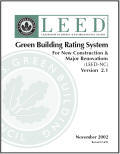December 2007
![]()
AutomatedBuildings.com
[an error occurred while processing this directive]
(Click Message to Learn More)
December 2007 |
[an error occurred while processing this directive] |
|
|

Jim Sinopoli PE, RCDD Author "Smart Buildings" |
"Technology means the systematic
application of scientific or other organized knowledge to practical tasks”
John Kenneth Galbraith, Economist, Author
|
|
|
|
|
|
|
|
|
|
|
|
|
|
|
|
|
|
|
|
|
[an error occurred while processing this directive] |
Integrating a building’s technology systems and constructing a sustainable or “Green” building have much in common. Green buildings are about resource efficiency, lifecycle effects and building performance. Smart buildings, whose core is integrated building technology systems, are about construction and operational efficiencies and enhanced management and occupant functions.
 Part of what a smart
building will deliver is energy control and energy cost savings beyond that of
traditional system installation, due to the tighter control system integration.
Smart and green buildings deliver the financial and conservation benefits of
energy management. One question then is how do smart buildings make a building
green? More specifically, how can smart buildings support and effect the LEED
certification of a green building?
Part of what a smart
building will deliver is energy control and energy cost savings beyond that of
traditional system installation, due to the tighter control system integration.
Smart and green buildings deliver the financial and conservation benefits of
energy management. One question then is how do smart buildings make a building
green? More specifically, how can smart buildings support and effect the LEED
certification of a green building?
Buildings can receive LEED certification by submitting documentation of meeting or exceeding certain technical requirements of the U.S. Green Building Council. One or more points are earned towards certification for each technical requirement that is attained. Four different levels of certification can be achieved based on the total points earned. For new construction the rating system is:
|
LEVEL |
POINTS |
|
Certified |
26-32 points |
|
Silver |
33-38 points |
|
Gold |
39-51 points |
|
Platinum |
52-69 points |
The rating system for new construction generally focuses on commercial buildings however rating systems for other building types have been and are being developed. In addition, there are three prerequisites that each building must meet prior to any rating:
(1) Fundamental commissioning of the systems
(2) Minimum energy performance
(3) The reduction of chlorofluorocarbons (CFCs) in HVAC and refrigerant equipment (related to ozone depletion).
So how does a Smart Building approach align and support the Green Building approach, and more specifically, how does a Smart Building approach facilitate meeting or exceed the technical requirements of the credits and points of the LEED rating system? Here are a few possibilities:
Optimize Energy Performance (1-10 points)
Buildings can receive points for increasing their energy performance beyond the prerequisite energy performance. Typically, a building simulation using the “Energy Cost Budget Method” is used to demonstrate the energy performance and points are earned based on the percentage improvement above the baseline.
One of the potential strategies to obtain credits and points is to design the building systems to maximize energy performance. The focus is obviously on HVAC and interior lighting systems (referred to as “regulated” systems), both of which fall under the umbrella of a smart building.
Other systems are referred to as “unregulated” systems and include plug loads. Plug loads are everything that plug into the electrical distribution system, such PCs, displays, cameras, vending machines, copiers, etc. Plug loads make up 9-20% of a typical building’s electrical load, depending on the building type and density of devices. Buildings can receive “innovation” credits if the energy consumption of the non-regulated systems such as plug loads is also reduced.
Enter a smart building where an IP network is able to provide power-over-Ethernet (POE) to a range of “plug load” devices. POE not only supplies low voltage rather than high voltage power to these devices but more importantly, provides the means to control power to the device. Central control of the POE devices allows for devices to be turn on or off based on a predetermined schedule, a sensor, or an event, such as an occupant’s use of an access card. The result can be reduced consumption of power to devices, reduced power usage and a greener building. In addition POE reduces the use of materials, eliminating the need to provide a power cable to the device. POE can be considered an innovative candidate for optimizing the energy performance of a building and obtaining points.
Additional Commissioning (1 point)
Fundamental building commissioning is a prerequisite for LEED certification and essentially addresses system commissioning after substantial completion of system installation. Additional commissioning involves an independent commission agent (independent of the design team or the system contractors) that is part of the design and construction process from the beginning. Since a smart building encompasses the integration of all of the systems in the building, this additional level of commissioning is not really an option, but should be a requirement to ensure the fulfillment of the benefits of integrated building technology systems, and in the process, pick up one LEED credit.
[an error occurred while processing this directive] Measurement and Verification (1 point)
LEED credits are awarded if the project team can demonstrate that they have provided for the accounting and optimization of energy and water consumption. This involves metering systems and management tools, such as an energy management application that can track actual usage and cost, configure “what if” scenarios, compare projected cost with actual costs, etc. Such an application can be stand alone or part of a portfolio of facility management applications and should be considered a standard component needed to manage a smart building.
Carbon Dioxide (CO2) Monitoring (1 point)
LEED credit is given for a carbon dioxide monitoring system that can provide data on the ventilation of spaces which then can be used to adjust the HVAC system. The result is improved indoor air quality and occupant comfort. The monitoring sensors can be designed based on activity levels, zones or space use and then integrated in the building automation system, therefore becoming part of a smart building.
Controllability of Systems: Perimeter and Non-Perimeter Spaces (1 point each)
LEED credit is provided if the building affords individual occupants or specific groups in multi-occupant spaces (conference rooms, classrooms, etc.) the capability to control the lighting, temperature and ventilation of their spaces. One credit is provided for perimeter and non-perimeter spaces. This level of individual control, while still maintaining overall system management, is part of programmable lighting and HVAC control systems. Many times this type of control is provided to occupants through touch screens or other smart building systems such as VOIP telephones.
Thermal Comfort: Permanent Monitoring System (1 point)
Similar to the CO2 monitoring, LEED provides credits for temperature and humidity monitoring systems integrated into the HVAC control system to maintain occupant comfort and automatically adjust conditions as needed. The objective is through additional monitoring and sensors the smart building systems collect more data on system and occupant use which is then turned into actionable information to optimize the system performance and energy usage.
Innovation in Design (1-4 points)
LEED will grant points for innovative ideas not covered by the Green Building Ratings System or ideas that substantially exceed a LEED performance credit.
For example, one possible scenario could involve the cabling of the building. A converged and standardized cable infrastructure for a smart building should require less cable and fewer cable pathways, thus reducing the use of materials and saving energy. Innovations such as zone cabling further reduce the use of materials. Standardization of the cable also allows for greater potential to reuse the materials, thus saving energy. Extensive deployment of wireless within a building further reduces the need for cable and minimizes the use of materials.
The rating system allows you to get points for thinking outside the box. Potential innovations where integrated building systems and connected real estate would facilitate the reduction of energy and the reuse and recycling of materials seem limited only by imagination and creativity.
High performance buildings need not be green or smart, but must be both. Smart buildings make green buildings greener, and green buildings make smart buildings smarter. The result is that building owners and managers have enhanced performance and functionality in their buildings.
For more information about smart buildings, the designs of building technology systems or to schedule a Continuing Education program for your office write us at info@smart-buildings.com.

[an error occurred while processing this directive]
[Click Banner To Learn More]
[Home Page] [The Automator] [About] [Subscribe ] [Contact Us]